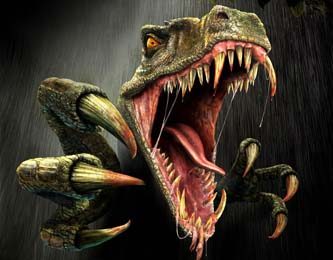125 mln-year-old dinosaur had skull like Indian fish-eating ‘gharial’
 Washington, Jan 14: Biologists have analyzed the fossils of a dinosaur found near Dorking in Surrey, UK, in 1983, to come up with the conclusion that it had a skull that functioned like the Indian fish-eating ‘gharial’ – a crocodile with long, narrow jaws.
Washington, Jan 14: Biologists have analyzed the fossils of a dinosaur found near Dorking in Surrey, UK, in 1983, to come up with the conclusion that it had a skull that functioned like the Indian fish-eating ‘gharial’ – a crocodile with long, narrow jaws.
Discovered by an amateur collector, the fossils are of an early Cretaceous dinosaur referred to as ‘Baryonyx walkeri’, which is around 125 million years old, and belongs to a family of dinosaurs called spinosaurs.
According to Dr Emily Rayfield from the University of Bristol, UK, on excavation, partially digested fish scales and teeth, and a dinosaur bone were found in the stomach region of the animal, demonstrating that at least some of the time this dinosaur ate fish.
“Moreover, it had a very unusual skull that looked part-dinosaur and part-crocodile, so we wanted to establish which it was more similar to, structurally and functionally – a dinosaur or a crocodile,” she said.
Using computer-modelling techniques, Dr Rayfield demonstrated that while Baryonyx was eating, its skull bent and stretched in the same way as the skull of the Indian fish-eating gharial.
“We used an engineering technique called finite element analysis that reconstructs stress and strain in a structure when loaded. The Baryonyx skull bones were CT-scanned by a colleague at Ohio University, USA, and digitally reconstructed so we could view the internal anatomy of the skull,” said Rayfield.
“We then analysed digital models of the snouts of a Baryonyx, a theropod dinosaur, an alligator, and a fish-eating gharial, to see how each snout stressed during feeding. We then compared them to each other,” she added.
The results showed that the eating behaviour of Baryonyx was markedly different from that of a typical meat-eating theropod dinosaur or an alligator, and most similar to the fish-eating gharial. Since the bulk of the gharial diet consists of fish, the study suggested that this was also the case for Baryonyx back in the Cretaceous period.
According to Dr Angela Milner from the Natural History Museum, the co-author on the paper, the CT-data revealed that although Baryonyx and the gharial have independently evolved to feed in a similar manner, through quirks of their evolutionary history their skulls are shaped in a slightly different way in order to achieve the same function.
“This shows us that in some cases there is more than one evolutionary solution to the same problem,” she said.
The unusual skull of Baryonyx is very elongate, with a curved or sinuous jaw margin as seen in large crocodiles and alligators. It also had stout conical teeth, rather than the blade-like serrated ones in meat-eating dinosaurs, and a striking bulbous jaw tip that bore a rosette of teeth, more commonly seen today in slender-jawed fish eating crocodiles such as the Indian fish-eating gharial. (ANI)